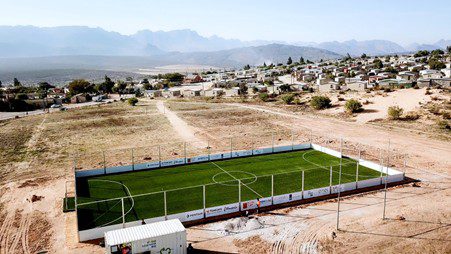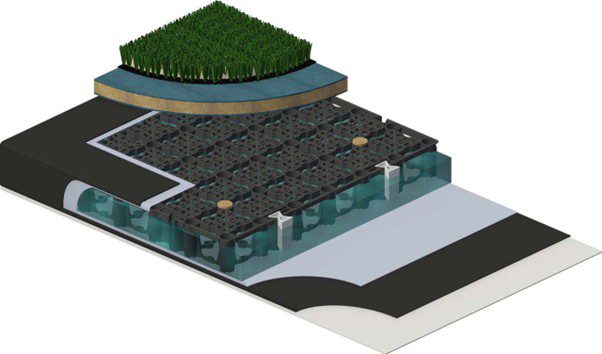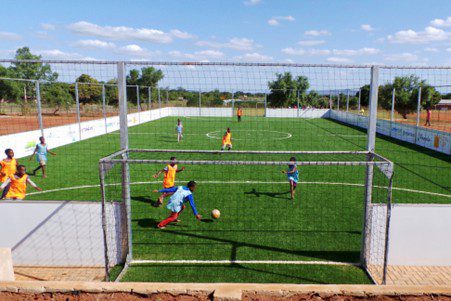
A project in South Africa is using a form of synthetic turf to enable freshwater recycling, in what seems a novel attempt to solve two problems at once: drought and a lack of recreational facilities. The two ‘Cruyff Courts’ are simultaneously providing a high-quality playing surface while integrating an advanced water collection and filtration system under the field, providing the local community with fresh potable water.
The project was headed up by EMEA Synthetic Turf Council (ESTC) member Dutchblue, who provided an advanced water collection and filtration system through its partners Project GreenSource SA.

The ‘Catch-Store-Reuse’ sports system captures rainwater, stores it in its subbase, and purifies it in a GreenSource container (a small structure adjacent to the field housing the filtration unit). Runoff collected by the system is filtered to remove contaminants, including bacteria and metals, before being pumped to a fountain for use as potable water. The purified water can then be used via a tap on the outside of the container.
Core components of the system appear to include:
-
- A synthetic turf pitch, installed over layers of geotextiles, sand, and drainage to act as an efficient rainwater catchment surface.1
- Pre-filtration and storage: Collected rainwater—and potentially groundwater or river water—is channeled through pre-filtering layers and stored in an underground reservoir to keep it cool and protected.2
- Ultrafiltration membranes: The heart of the system is Pentair UF (ultrafiltration) membranes, which remove suspended solids, bacteria, and even viruses—providing safe, potable water.3
In terms of output and capacity, each GreenSource facility can seemingly deliver up to approximately 50 litres per minute of filtered, safe drinking water. Annual output can reach up to 17 million litres, with storage capacities of tens of thousands of liters.
Together with the local community’s help, the project was completed in December 2024, and training is being given to maintain the pitches throughout their lifetime.
The duality of providing a high-quality sports playing field and clean water for the local community has resulted in some great benefits for the local area. These include potable water supplies for periods of prolonged drought and a recreational area for children and adults to play sports safely. The courts have also helped foster a sense of community identity, serving as a social hub as well as a sports facility.
Stefan Diderich, Director General at ESTC, said: “This project is a perfect example of how synthetic turf can operate not just as an enhanced playing surface, but also as a force for good in fighting drought and other hydrological issues around the world.

“Training the local community to maintain the pitch ensures they will have a lasting impact and can provide users with a high-quality surface as well as a source of clean drinking water for years to come.”
South Africa has in recent months been grappling with one of its most severe droughts in recent history, affecting approximately 61 million people across Southern Africa.4 The prolonged drought has led to significant water shortages, impacting both urban and rural communities.
Find out more about ESTC.
Notes
[1] https://xflow.pentair.com/en/news/greensource-sports-grounds.html?utm_source=chatgpt.com
[2] ibid
[3] ibid
[4] Southern Africa faces heightened drought risk in 2025: Global Water Monitor report – CITEZW

